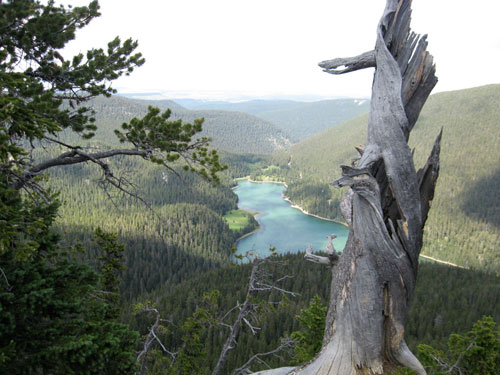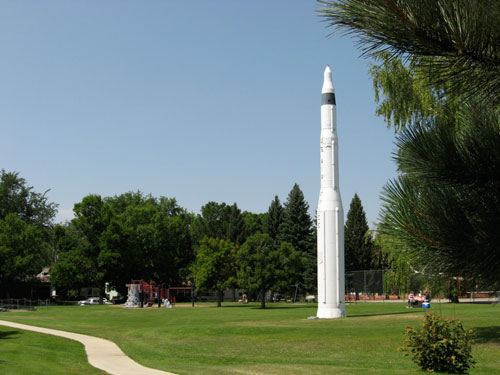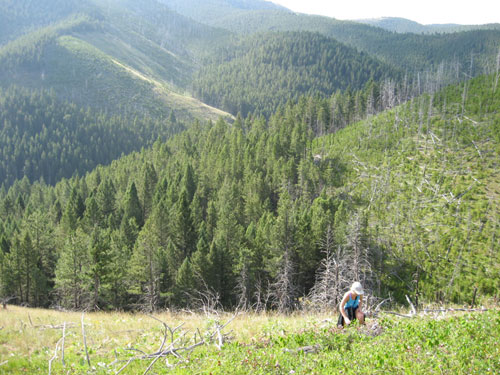Essay by Lorraine Berry
Feeling “Right-Sized” in Montana
In my early twenties, I began exploring the area around Seattle, my hometown. Because I didn't know what lay beyond certain familiar highways, I’d get out the map of Western Washington and choose a route.
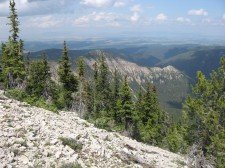 One hot day, I drove up I-5 and got off at the Snohomish exit. Route 2 picks up there, and if you follow it due east, it takes you through the cut in the Cascades known as Stevens Pass and into Eastern Washington. I chose, instead, to veer north on Highway 92, toward Granite Falls.
One hot day, I drove up I-5 and got off at the Snohomish exit. Route 2 picks up there, and if you follow it due east, it takes you through the cut in the Cascades known as Stevens Pass and into Eastern Washington. I chose, instead, to veer north on Highway 92, toward Granite Falls.
I was intrigued by a dotted line on the map—the hesitancy of its existence, the possibility that it might not be there when I arrived. I wanted to know what such a road might look like. So, following the route that led out of Granite Falls, I drove on.
The Cascades are serrated mountains. Jagged peaks, many of them snow covered year round, thrust themselves up thousands of feet. When you’re driving on a highway and see signs warning you to beware of falling rocks and realize you can’t see the whole of the mountain you’re driving by because it is mammoth, the effect is telescoping.
I was filled with an electric sense of wonder that something can truly be so beautiful that it takes your breath away, and, at the same time, I felt so small. Tiny. I’ve heard wise people call that “feeling right-sized.” And that’s it. A reminder, a physical reminder, that I am small and the mountain is huge and that is as it should be.
The towns—tiny dots on the map—had names like Robe, Verlot, and Silverton and consisted of only a few houses. The towns drew me closer to the Glacier Peak Wilderness area. Fast-moving rivers curled and spun next to the roads. From the car, I could see the rocks on their glacier-fed bottoms and the glint off the water, sparkling like moonglow.
At Silverton, the road began to curve farther northward, and pavement became dirt. I had reached the dotted line on the map.
The right side of the road was cool, cast into black penumbra by the stands of Douglas fir. On my left lay a dry marsh—islands of yellowed grass surrounded by the remains of pond water, out of which rose snags, the backbones of dead trees stripped of any arms.
It was hard to say if the snags were the remnants of a fire that had come through long before, or, more likely, of trees that had somehow been passed over when the area was first logged. The Douglas fir, however impressive, was not virgin timber. Magnificent trees with trunks that would have defied the spans of linked men’s arms had undoubtedly been felled a hundred years before, when men had decided that no obstacle would keep them from culling as much from the land as they could.
The road continued on for a bit, forest on both sides, before turning to follow the river, with trees now only on one side and roaring waters on the other. I pulled my car onto the side of the road and picked my way down to the water’s edge.
Sapphire skies and a warm sun formed a canopy above granite boulders, over which tumbled the combined waters of the Sauk and Stillaguamish Rivers. The shore was composed of loose stones, fist-sized mostly, that had been thrown up by the churning water. Some of the rocks were as large and flat as altar stones, and I sat on the edge of one and trailed my bare feet in the river. The freezing water—glacier melt from farther upstream—was a test of endurance, and I pulled my feet back onto the warm stone.
Sitting there, I felt peace and passion, wholeness, as if I were part of the tableau rather than an intruder.
• • •
Twenty-five years later, being in love with Rob felt to me like that day in the Cascades.
It took me a long time to learn how to be in love. I thought I knew about love—I had been married for twelve years—but it wasn’t until I’d been divorced for a number of years that I really got my first taste of it, only to lose it in the most tragic way. Then I went back to the work I’d been doing—finding myself, falling in love with myself, learning what it was that made me feel as if I were the right proportion in the world. Neither too big nor too small, too hard or too soft, too hot or too cold, but just right.
Just.
Right.
In January of 2008, I met Rob, and he was just right. The creative director at an advertising firm, a person who had majored in creative writing, a man who loved words and puzzles, who appreciated language and beauty—and a good Scotch—Rob was the one. Rob reminded me of what it felt like to be a Pacific Northwest girl. Being in love with him felt like exploration.
These were feelings that I had not experienced in a long time—for the fifteen years that I had been living in the Northeast—and so it made sense to me that the first place I wanted to take Rob was out West.
We couldn’t go to Seattle—I had no kin left there and the city was too expensive to consider a hotel—but I was lucky: I had friends who owned a cabin in the Montana wilderness. I asked to rent it, but my dear friends loaned it to me so that I might bring my new love there. And so we headed to the Judith Mountains.
• • •
Our first day at the cabin, we drove into nearby Lewistown to buy groceries.
From the road, the missile silo appeared innocuous enough: a small, fenced-off area within which was a mound of tilled earth. At first, we thought some farmer had planted valuable crops and fenced them off from deer, antelope, or rabbits. But, almost simultaneously, both of us knew what we were looking at. It scared me. And it angered me.
I had become aware in my adolescence that I was living on contested land. Huge swathes of Eastern Washington were being used for nuclear waste. Those areas had a generic, hygienic-sounding name—like “nuclear waste disposal” —but they were really nuclear trash heaps. Big trucks drove into Washington to get rid of nuclear waste created in other places. The eastern part of the state was treated as if that land didn’t mean anything, as if, as we often felt, it was there to be used by the rest of America as a dumping ground.
When I was a teenager, Washington had a governor, Dixie Lee Ray, who wanted to build more nuclear power plants in our state, just as a nascent environmental movement was pushing back against nuclear waste. Later in my teens, I demonstrated against the building of the Trident nuclear submarines, whose home port was intended to be in Puget Sound. I grew up with the constant warning that because of Boeing’s Seattle home office, the various military bases in our midst, and the nuclear power plants, we would never even know a nuclear war had started because we’d be the first to go.
So when Rob and I saw our first missile silo, I felt blasted. I had wanted to show him just how glorious parts of the West were, but now we’d stopped the car and were both staring, knowing that underground, just a few hundred yards from where we sat, was a nuclear warhead. I wished there was a fire ax in the car so I could grab it and (don’t ask me how I would have done this) hammer that missile until I beat it into a ploughshare.
• • •
By the next morning, my anger had dissipated. Rob and I sat outside the cabin hand-in-hand, clutching mugs of coffee and marveling at our surroundings.
The cabin sat in the bowl of a narrow valley surrounded by various (and strangely anonymous) peaks that were part of the Judith range. It had been designed by our architect host to take advantage of the views, and what we could see from the wraparound balcony were the tops of ridges.
The mountains had been named in honor of love. Historical documents relate that William Clark, on his famed expedition with Meriwether Lewis, named a Montana stream “Judith’s River,” in honor of young Julia Hancock of Fincastle, Virgina, a cousin whom he knew as “Judy” and who two years later was to become his wife. “South Mountain,” which the explorers saw in the distance, was renamed “Judith Mountain.”
Our cabin was at the 4,000-foot level, so the ridges didn’t look that high. The highest peak in the Judiths, Judith Peak, is 6,400 feet, which is a thousand feet higher than the highest point in New York State. During my fifteen years in the Northeast, I had turned into a flatlander, but there in the Judith Mountains, I was getting my mountain legs—and perspective—back.
Fire had swept through this area about a decade before our visit, and a fire line marked the hillside that most fascinated us. The sky was aster blue, and the burnt, bare trees looked like punji sticks shooting up from the crest of the ridge. Curiosity demanded we climb.
• • •
For a while, the dirt road that went past the cabin provided a trail. I recognized a few of the wildflowers around me: Indian paintbrush—salmon-colored, not red; blue harebells; California poppies; gigantic stalks of cow parsnip. But I also saw dozens I couldn’t identify—not something I’m used to.
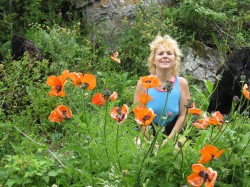 I was taken by surprise, delighted, enthralled that these mountains could produce such a spectrum of colors. My hungry eyes tried to absorb as much as I could, as though I were a magpie—”Ooooh! Shiny!” I found myself unable to focus for long on one flower before another distracted me.
I was taken by surprise, delighted, enthralled that these mountains could produce such a spectrum of colors. My hungry eyes tried to absorb as much as I could, as though I were a magpie—”Ooooh! Shiny!” I found myself unable to focus for long on one flower before another distracted me.
As my nose filled with the scent of the warm, toasted tree needles that layered the paths, I was rocketed back to my long-ago explorations in the Cascades. There, warm pine is evidence that the sun is shining—which, except for rare occasions, means you are hiking on the eastern side, the dry side, of the Cascades. The western side, where the clouds dump their rain, smells of mold and decomposition. The eastern side smells like baked wood, the faintest traces of vanilla, the clean smell of healthy human sweat as it trickles down the back of your skimpy tank top.
Montana smelled like the eastern Cascades, and it evoked that sense of place that I had never felt in the deciduous forests of the Northeast.
We reached the fire boundary. A multitude of trees lay where they had fallen. Some still bore char marks, but most were like old bones, picked clean by rain and wind and snow and sun. The trees that were still standing—the ones that we had noticed from the porch—were most likely Douglas fir. Now the forest floor was hidden, every space filled by soft, brushy Douglas fir and lodgepole pine rising among the tree carcasses. New life, feeding off the nutrients that fire had returned to the soil.
We continued to climb through the stripling trees, as even more wildflowers appeared. I halted when I saw, growing out of bare rock, a creamy, teacup-sized flower with yellow markings around its stamen. I resisted the urge to touch it, convinced my fingers would damage it, although its hardiness—high on this rock—was evident. Later, I’d find out it was a mariposa lily.
When we reached the top edge of the first ridge, we walked along it, climbing higher into the forest of gnarled, fire-damaged trees, the new growth below us.
Ravens—a dozen or so—chattered above us, swooping and circling. A flock of ravens is called a terror, but I didn’t find their presence mournful or worrisome. Instead, I felt they had something important to say; only my inability to speak “ravenish” excluded my joining in. We stopped to sit atop the ridge and listened to their talk.
Surrounding me were reminders that loveliness can come from loss. I felt at peace amidst the intrinsic beauty of the dead trees, twisted into sculptures; the new forest growing beneath my feet; the flowers blooming under the harshest of conditions. I was in love, and my love sat next to me.
The presence of new growth arising from destruction was in my life story, too. Rob was getting the Pacific Northwest girl, who had begun to love herself on an altar stone by a river. He was getting the Northeast woman, who was raising and loving two daughters at the same time that she scrabbled to raise herself. He was getting the mariposa lily, blooming after finding a way to be nourished by bare rock.
Some day, I thought, Rob and I will return, and the Minutemen will be gone. The destroyer of worlds will be overgrown with bear grass and poppies, wild hyacinths and blue-eyed Marys, forget-me-nots—all turning their cheerful faces to the sun as life reasserts itself on the high prairie.
Publishing Information
- The Journals of Captain Meriwether Lewis and Sergeant John Ordway: Kept on the Expedition of Western Exploration, 1803-1806 by Meriwether Lewis, John Ordway, and Milo Milton Quaife (State Historical Society of Wisconsin, 1965 [©1916]; reprinted by Nabu Press, 2010).
- To learn more about the Judith Mountains, see the Camping, Hiking, and Traveling in Montana website.
Art Information
- “Montana Mountains,” “Crystal Lake in the Snowy Mountains, Montana,” “The Shell of a MMIII Minuteman Missile in a Playground in Lewistown,” “Lorraine with Poppies,” and “At the Fire Line” © Robert Stiene; used by permission
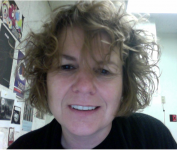 Lorraine Berry is a contributing writer at Talking Writing.
Lorraine Berry is a contributing writer at Talking Writing.
“If you shine too much light in a young doe’s eyes, she’ll freeze. Move the arc of the flashlight’s beam, and you can watch her in the shadows, flicking her ears as she listens to the signal that tells her it’s okay to run, that the safety of the woods is illusory and the way forward lies across a meadow drenched in the light of the moon.” - Raquette Lake

